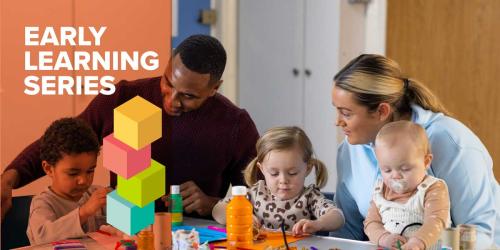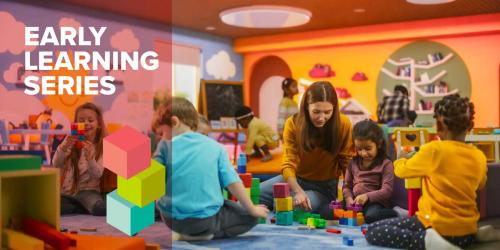Six Ways Principals Can Support the Transition to Kindergarten

On their first day of kindergarten, students are typically the same age but come from a wide range of experiences. Some of the nearly four million students entering kindergarten each year have attended preschool, center-based childcare, or a family daycare, while others stayed with grandparents or at home with mom or dad. Just as wide ranging is how ready they are to become thriving students. Research shows that children who begin kindergarten at the lowest academic and social skill levels are at a high risk of future poor academic performance and negative experiences later in life.
With evidence suggesting that more than half the achievement gap in later school years is already present when students begin kindergarten, it’s important for school systems to look at the experiences and opportunities they provide to their youngest students and their families. But, what can elementary school principals and administrators do to create an environment that supports learning for all young students?
When it comes to closing the achievement gap in the early grades, here’s what we know: Students have a better chance of success later on when they make smooth transitions into school and when their schools have effective leadership.
We also know that engaging in the following six practices—backed by research—can help schools ease the transition for new kindergarten students and support their academic success through the early grades.
Involve Families and the Community in the Transition to Kindergarten
According to the National Association of Elementary School Principals, strong connections between schools and families help stimulate a child’s development. Examples include parents participating in classroom activities, and schools facilitating two-way communication with families and incorporating ideas and languages from a child’s home culture.
Parent-teacher relationships also have a positive effect on incoming kindergarteners. To promote student transitions and establish ongoing communications, encourage teachers to visit homes and get parents and children to visit school before the school year starts. When conducting home visits, it’s important for teachers to allow parents to share their expertise regarding their own children. Family engagement also deepens when parents are actively involved in decisions about their child’s education and when they are kept informed about kindergarten expectations and how parents can help.
Other activities that increase parental involvement include creating tip sheets for parents, using website and ad campaigns to share kindergarten transition materials, sending out class lists early so parents can get to know teachers and other parents, providing training for parents to become stronger participants in their child’s early learning, and encouraging parents to volunteer in classrooms.
Create Professional Development Opportunities Specific to Teaching Young Children
Principals can provide support and professional development for kindergarten teachers on developmentally appropriate practice and how to encourage student learning through play. Scheduling professional development for preschool and kindergarten teachers together promotes collaboration and helps create smooth transitions for students.
Principals can also enhance their own knowledge by exploring competencies for effective principal practice and school-based policies that lead to positive child outcomes.
Align Standards, Curriculum, and Instruction
With schools across the country working to align instruction to new, rigorous standards, principals can collaborate with teachers on practices that meet standards and focus on developmentally appropriate teaching.
When becoming familiar with the domains of childhood development, it’s useful to learn about state-specific early learning guidelines and assessments. These frequently focus on language development, literacy, mathematics, science, creative arts, social and emotional development, approaches to learning, and physical health and development.
In many states, the early childhood education and K–12 systems operate independently, which creates disconnected educational experiences for students. Thus, adapting instructional practice to standards can create opportunities to work more closely with local early childhood providers to create aligned curricula that equip students for kindergarten.
Review, Use, and Share Student Data with Families and Teachers
Principals can use data—such as kindergarten entry assessments (KEAs)—to learn more about their incoming kindergarten students. Because KEAs often focus more on academics than other domains of early learning and young children don’t always test well, we suggest not relying on a KEA alone. Principals should consider multiple forms of assessment to understand children and guide planning—and to support teachers in other methods, such as observation and portfolios of student work.
Make Sure Children Come to School
In Oregon, between 18 and 23 percent of students are chronically absent, and chronic absences in early grades can lead to lower academic performance and lower graduation rates, according to the Children’s Institute.
Principals can make a difference by making sure families call if their student will miss school and following up with parents who don’t call. Principals can also partner with community agencies that help prevent absenteeism for younger students.
Build Awareness of Transition Programs
An emerging practice is partnering with groups that help children who might struggle with the transition to kindergarten. An example from Portland includes the Ready for Kindergarten Collaborative.
Additional resources
- You can learn more about aligning Pre-K–3 instruction to standards in this guide from the Education Commission of the States and from a blog by the National Institute for Early Education Research on concerns related to the Common Core State Standards and early childhood education.
- Yale University’s Diane Dodge provides guidance on how teachers can use assessment to improve their work with young children in a YouTube video. A Harvard Family Research Project publication provides an example from Georgia on using data for this purpose and to guide teacher planning.



